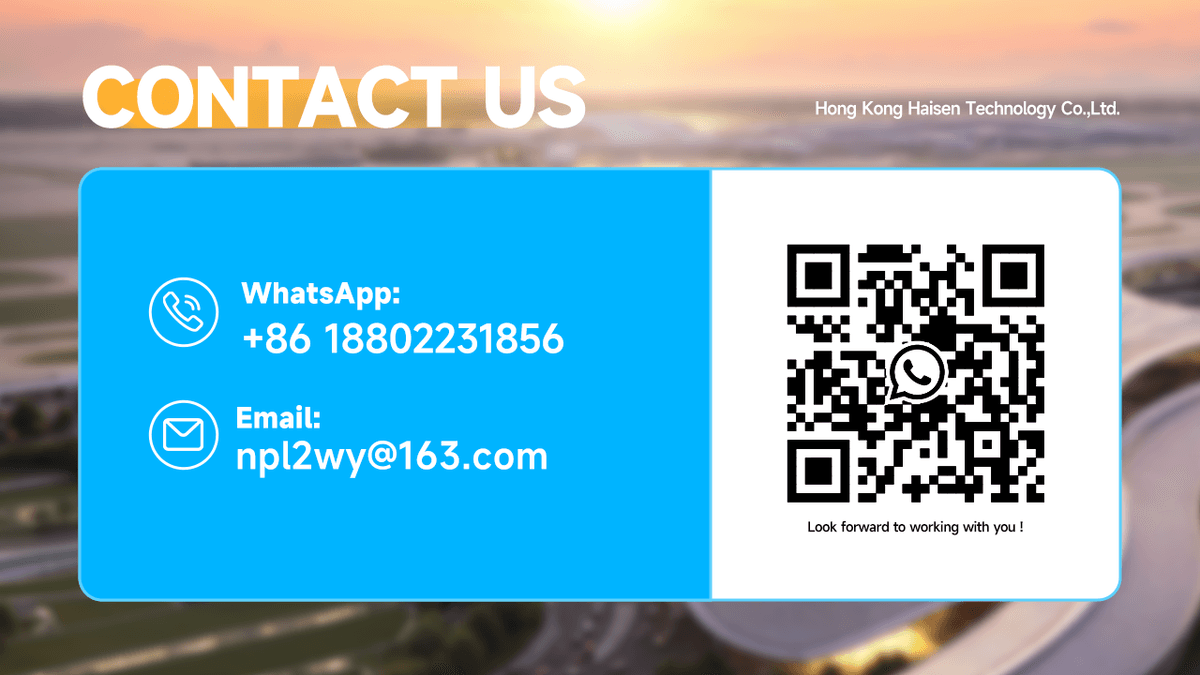In the fast-paced world of aviation, Runway Approach Lights stand as non-negotiable safety pillars, guiding aircraft through the critical final landing phase. These specialized lighting systems are far from decorative—they are precision tools that cut accident risks, especially when fog, rain, or darkness limits visibility. For airlines, airports, and maintenance teams, understanding their design, functionality, and latest tech is key to keeping skies safe and operations smooth.
1. What Are Runway Approach Lights? Core Definitions & Purpose
Runway Approach Lights (RALs) are strategically placed lighting systems at runway thresholds. They create a visual pathway for pilots during descent and landing, turning abstract navigational data into clear, real-time cues. Unlike basic runway lights, RALs focus on the approach phase—the 1–3 minute window when pilots align the aircraft with the runway, adjust altitude, and prepare for touchdown.
Their core purpose is to solve three critical pilot challenges:
- Alignment Clarity: They mark the runway’s extended centerline, so pilots avoid drifting left or right.
- Distance Awareness: Specific light patterns (like spaced white lights) show how far the aircraft is from the runway threshold.
- Descent Guidance: Colored or flashing lights signal if the aircraft is too high, too low, or on the correct glide path.

RALs are not one-size-fits-all. Their design adapts to airport needs:
- Small Airports: Simple systems (e.g., 420m extended centerline lights) for visual flight rules (VFR) operations.
- Major Hubs: High-intensity systems (e.g., 900m extensions with flashing “rabbit” lights) for precision instrument approaches (Category I–III).
- Extreme Weather Airports: LED-based RALs with adjustable brightness to cut through heavy fog or snow.
2. Why Runway Approach Lights Matter for Flight Safety
The impact of Runway Approach Lights on safety cannot be overstated. They turn high-risk landing scenarios into manageable ones by addressing two top causes of landing incidents: low visibility and pilot misjudgment.
2.1 Reducing Low-Visibility Risks
In fog, rain, or night conditions, pilots lose natural visual references (e.g., terrain, runway edges). RALs fill this gap by:
- Providing a continuous “light trail” to the runway, even when visibility is below 800 meters.
- Using high-intensity LEDs that penetrate mist better than traditional incandescent bulbs.
- Incorporating red “stop” lights at the runway end to prevent overshoots.
ICAO data shows airports with compliant RALs have 60% fewer low-visibility landing incidents than those without. For example, a 2024 case at London Heathrow: a Boeing 787 encountered unexpected fog, but the airport’s Category III RALs kept the pilot aligned—resulting in a safe touchdown with zero visibility to the runway until 50 meters.
2.2 Guiding Pilot Decision-Making
Pilots make split-second choices during approach. Runway Approach Lights reduce guesswork by:
- Offering immediate feedback: If the RALs appear “broken” or misaligned, pilots know to abort the approach.
- Reducing workload: Clear visual cues mean pilots spend less time checking instruments and more time focusing on flight controls.
- Building confidence: Familiar RAL patterns (e.g., ICAO-standard “rabbit” flashes) calm pilot anxiety at unfamiliar airports.
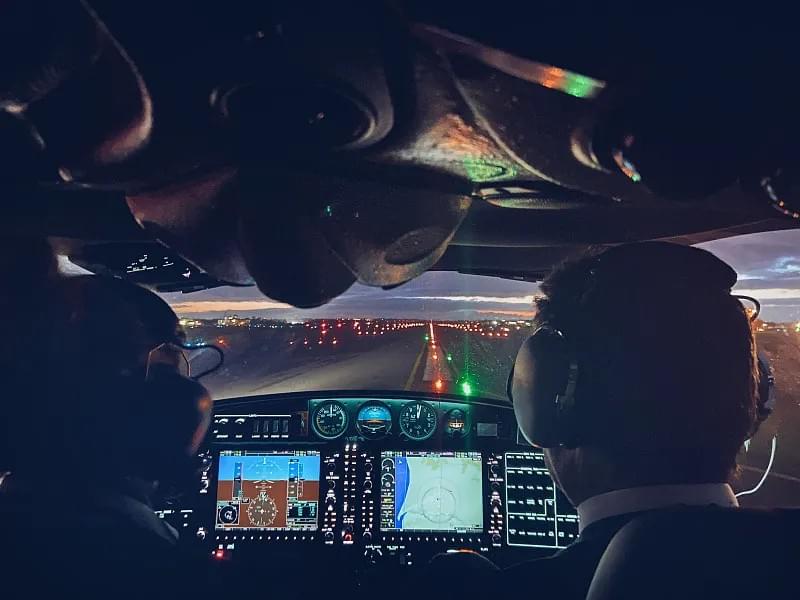
2.3 Supporting Global Safety Standards
Every Runway Approach Light system ties into ICAO’s (International Civil Aviation Organization) global framework. This standardization ensures pilots from any country recognize RAL patterns—whether they’re landing in Tokyo, New York, or Nairobi. Compliance with ICAO rules isn’t just bureaucratic; it’s a safety net for cross-border flights.
3. Key Components of a Runway Approach Light System
A reliable Runway Approach Light system is more than just a row of lights. It’s a network of components working together to deliver precise, consistent guidance. Below are the critical parts:
3.1 Light Fixtures: The Visible Core
- Centerline Lights: White, fixed lights along the runway’s extended centerline. Spaced 30m apart for precision approaches (Category I–III) and 60m for VFR. They extend 420m–900m from the runway threshold.
- Threshold Lights: Green lights marking the start of the runway. They signal “begin touchdown zone” and are visible from 3–5 km away.
- Sidebar Lights: Red lights running parallel to the centerline (270m from the threshold). They warn pilots if they’re drifting off the approach path.
- Sequence Flashing Lights (“Rabbit”): White lights that flash from far to near the runway. They simulate a moving “rabbit” to guide pilots toward the threshold, common in Category II/III systems.
3.2 Control & Monitoring Systems
Modern Runway Approach Lights rely on smart tech to stay reliable:
- Automated Brightness Adjustment: Sensors detect light conditions (e.g., dawn, heavy rain) and tweak RAL brightness—avoiding glare at night or dimness during overcast days.
- Real-Time Fault Detection: Systems like Haisen’s Light Intensity Tester monitor each light’s output. If a bulb fails, maintenance teams get an alert within 60 seconds.
- Remote Control: Air traffic control (ATC) can switch RAL modes (e.g., VFR to IFR) from the tower, no on-site visits needed.
3.3 Power Backup
RALs can’t fail during a landing. So they use:
- Dual Power Supplies: Main grid + backup generator, with automatic切换 (less than 1 second) if the grid fails.
- Battery Backups: For critical lights (e.g., threshold, sidebar), ensuring 30+ minutes of power during outages.
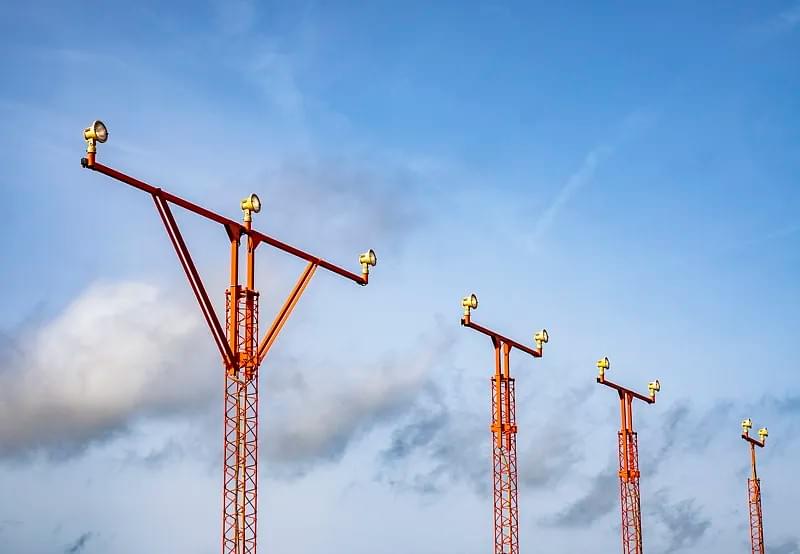
4. Types of Runway Approach Lights: VFR vs. Precision Systems
Not all Runway Approach Lights serve the same purpose. They’re categorized by the type of approach they support—visual or instrument.
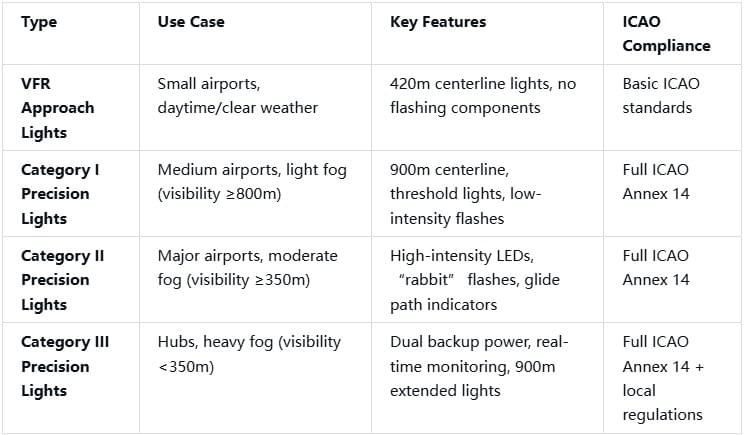
The most common precision system is the ALS-F (High-Intensity Approach Lighting System with Sequenced Flashes). It includes:
- 247 fixed lights (white centerline, green threshold, red sidebar).
- 15 “rabbit” flashes that run toward the runway (1 flash/second).
- Compatibility with Category I–III approaches—making it a top choice for busy airports like Dubai International and Atlanta Hartsfield-Jackson.
5. The ICAO System: Standardizing Runway Approach Lights Globally
ICAO’s standards are the backbone of safe Runway Approach Light use worldwide. The organization’s Annex 14 (Aerodromes) sets strict rules for RAL design, installation, and maintenance—ensuring consistency across 193 member states.
5.1 Core ICAO Requirements for RALs
- Light Intensity: Minimum 10,000 candelas (cd) for precision systems, 5,000 cd for VFR.
- Color Codes: White (centerline), green (threshold), red (sidebar/end)—no exceptions.
- Extension Length: At least 420m for VFR, 900m for Category I–III.
- Maintenance Checks: Monthly light intensity tests, quarterly wiring inspections, annual full-system audits.
5.2 Why Compliance Matters
For airports, ICAO-compliant Runway Approach Lights mean:
- Global Flight Access: Airlines (e.g., Emirates, Delta) only use airports with ICAO-approved RALs—non-compliant hubs lose traffic.
- Lower Insurance Costs: Insurers offer 20–30% discounts for airports with certified RAL systems, as they pose lower risk.
- Faster Incident Resolution: In case of a near-miss, ICAO compliance simplifies investigations (standardized RALs mean no “confusing patterns” to blame).
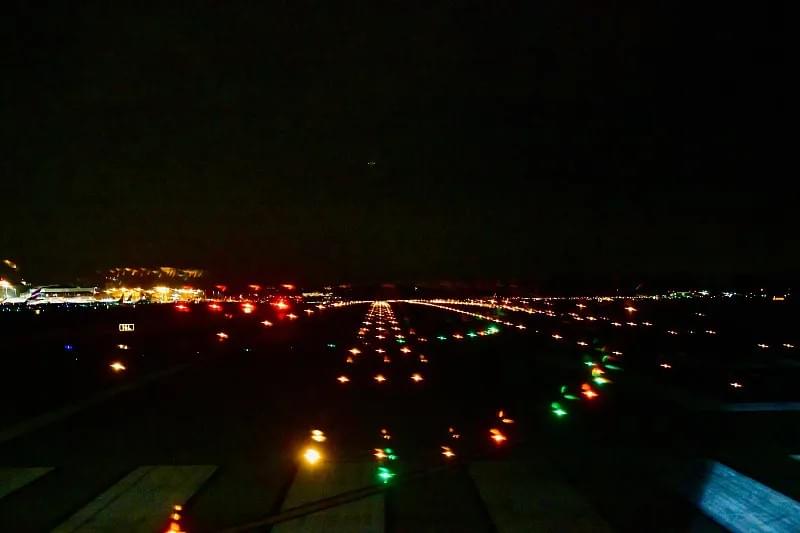
5.3 How to Verify Compliance
The best tool for ICAO compliance is a light intensity tester—like Haisen’s Global Light Tester. It:
- Measures light output in candelas, matching ICAO’s exact standards.
- Generates automated reports for auditors (no manual paperwork).
- Works with all RAL types (LED, incandescent, high-intensity).
6. Advanced Tech: The Future of Runway Approach Lights
Runway Approach Lights are evolving fast, driven by LED tech, AI, and real-time data. These innovations aren’t just “nice to have”—they’re making landings safer and more efficient.
6.1 LED Lights: The New Standard
LEDs have replaced traditional bulbs in 80% of global RAL systems, and for good reason:
- Energy Efficiency: LEDs use 70% less power than incandescents, cutting airport utility bills by $50,000–$100,000 yearly.
- Longer Life: 50,000+ hours of use (vs. 1,000 hours for incandescents)—reducing maintenance downtime.
- Better Visibility: LEDs produce a sharper, more consistent light that penetrates fog and rain better.
For example, Singapore Changi Airport upgraded to LED RALs in 2023. The result: 65% lower energy use for approach lighting, and zero bulb failures in the first year.
6.2 Real-Time Online Monitoring
Gone are the days of manual RAL checks. Modern systems use cloud-based monitoring:
- Sensors in each light send data (intensity, temperature, voltage) to a central dashboard.
- Maintenance teams get alerts via app if a light fails—even if they’re off-site.
- Airports can track RAL performance over time, predicting failures before they happen.
Haisen’s Real-Time Light Monitor is a leader here. It integrates with ICAO databases, so airports can instantly pull compliance reports for auditors.
6.3 AI-Powered Glide Path Guidance
Emerging tech adds AI to Runway Approach Lights:
- Cameras and sensors track the aircraft’s position during approach.
- AI adjusts RAL brightness or flash patterns in real time (e.g., brighter lights if the aircraft is off-course).
- It even predicts potential issues (e.g., “aircraft is 2° too low—trigger red warning lights”)—giving pilots extra time to correct.
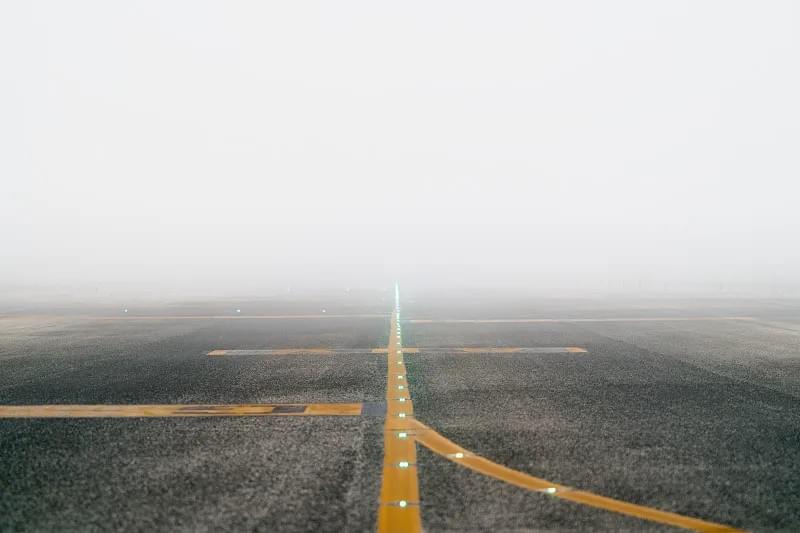
7. Case Studies: Runway Approach Lights Saving Lives
Real-world examples show how Runway Approach Lights turn crises into safe landings.
7.1 Case 1: Heavy Fog at Frankfurt Airport (2024)
A Lufthansa A320 was approaching Frankfurt in dense fog (visibility 200m). The airport’s Category III RALs—with 900m LED centerline lights and “rabbit” flashes—kept the pilot aligned. The aircraft touched down safely, even though the runway wasn’t visible until 30 meters. Post-incident, the pilot noted: “The RALs were my only reference—without them, I would have aborted.”
7.2 Case 2: Night Landing at Tokyo Haneda (2023)
A cargo plane (Boeing 777F) approached Haneda at night with a faulty instrument panel. The pilot relied on the airport’s RALs: green threshold lights to mark the runway start, and red sidebar lights to stay on path. The landing was smooth, and the crew credited the RALs with “keeping us on track when our instruments failed.”
7.3 Case 3: Snowstorm at Toronto Pearson (2025)
A WestJet 737 encountered heavy snow during approach. Pearson’s LED RALs—with adjustable brightness—cut through the snow, showing the pilot the centerline. The aircraft landed without slipping, and the airport reported no delays thanks to the RALs’ reliability.
8. How to Choose & Maintain Runway Approach Lights
For airports and maintenance teams, selecting the right Runway Approach Lights and keeping them in top shape is critical.
8.1 Choosing the Right RAL System
Follow these steps:
- Assess Airport Traffic: Major hubs need Category II/III systems; small airports can use VFR.
- Check Local Weather: Fog-prone areas need high-intensity LEDs; snowy regions need anti-ice light fixtures.
- Ensure ICAO Compliance: Pick systems tested to Annex 14 standards (ask for certification documents).
- Prioritize Tech Compatibility: Choose RALs that work with your existing monitoring tools (e.g., Haisen’s tester).
8.2 Maintenance Best Practices
- Daily Checks: Verify all lights are on and bright (use remote monitoring if possible).
- Monthly Tests: Use a light intensity tester to ensure output meets ICAO standards.
- Quarterly Inspections: Check wiring, power backups, and sensor calibration.
- Annual Audits: Hire a third party to confirm compliance and identify upgrade needs.
Common mistakes to avoid:
- Skipping intensity tests (leads to dim lights that fail in low visibility).
- Using non-ICAO bulbs (causes color mismatches that confuse pilots).
- Ignoring power backups (a grid failure during landing can be catastrophic).
9. Conclusion: Invest in Runway Approach Lights for Safer Skies
Runway Approach Lights are more than just airport infrastructure—they’re lifelines. They reduce accidents, guide pilots through chaos, and keep global aviation connected. As tech advances (LEDs, AI, real-time monitoring), RALs will only become more critical to flight safety.
For airports: Investing in ICAO-compliant, tech-forward RALs isn’t an expense—it’s a way to attract airlines, cut risks, and build trust with passengers. For maintenance teams: Using tools like Haisen’s Light Intensity Tester ensures RALs perform when they’re needed most.
The future of aviation is bright—and Runway Approach Lights will be leading the way.
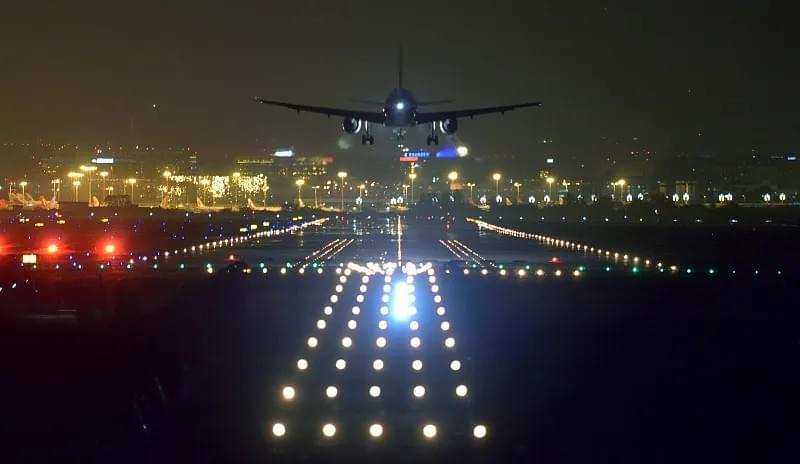
Would you like me to create a customized RAL system checklist for your airport, tailored to its size, weather conditions, and ICAO compliance needs? This checklist will help you assess your current setup and identify areas for upgrade.
